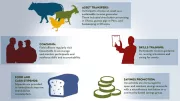Recent Blogs
Blog
How Useful Is “Usage” in Measuring Financial Inclusion’s Impact?
Financial account usage rates can tell us a lot about the state of financial inclusion, but high usage shouldn’t be confused with impact on customers’ lives.Blog
We Need to Talk About Credit
Digital credit is a testament to the ways in which technology and new business models can assist in the expansion of financial services to low-income households. But it also points to potential hazards of letting a market develop unchecked.Blog
2 Financial Services That Increase Smallholders’ Food Security
Evidence from around the world shows that savings and insurance help smallholder farmers to reduce hunger and manage production risks.Blog
Learning from Financial Inclusion Research: What Should We Expect?
Impact evaluations, reviews, reviews of reviews— there's no shortage of research on whether and how financial inclusion impacts the poor. What should we expect to learn from this growing body of work?Blog
3 Ways Financial Inclusion Improves Women’s Food Security
There is evidence that financial inclusion improves food security for women in at least three ways.Blog
Does Financial Inclusion Impact the Lives of the Poor?
A growing body of evidence is emerging on financial inclusion. The lack of a cohesive, nuanced story to bring the evidence together is leading to wildly different and overly simplistic interpretations.Blog
Financial Innumeracy: A Global Problem for Digital Finance?
Mounting evidence suggests financial innumeracy presents a bigger barrier to financial inclusion than is often acknowledged. Here are three ways to improve numeracy.Blog
China's Super Platforms: The Impact Question
What impact are super platforms having on low-income customers and small businesses? CGAP and Mastercard Foundation traveled to China to see firsthand.Blog
Interpreting the Financial Inclusion Numbers in Pakistan
Financial inclusion in Pakistan has improved slowly but steadily since 2008 according to most sources. However, depending on the source of data, the topline financial inclusion figure for Pakistan varies from 7% to 23%. Why?Blog
Focusing on the Poorest: What Does the Research Tell Us?
A new article in Science explains that the Graduation Approach is not only impressive, but has a lasting impact on the lives of the poorest.Blog
Microcredit Impact Revisited
A more nuanced picture is emerging that supports broad financial inclusion efforts. Mounting evidence shows that on the whole, access to formal financial services helps poor families in developing countries improve their lives.Blog












